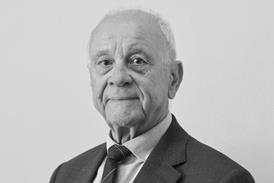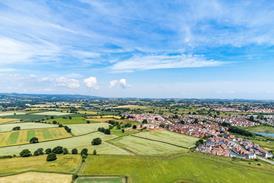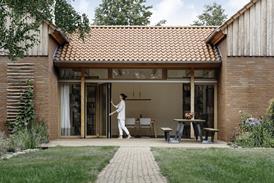As its name suggests, the Düsseldorfer Stadttor is designed to give drivers entering the city the impression of a 75 m-tall city gate. Situated close to the banks of the Rhine it overlooks the headquarters of the Northern Rhine Westfalian state government. It also sits directly above the southern entrance to the Rhine Bank tunnel. The building consists of two 16-storey towers, effectively pillars, linked by three storeys of attic level offices, creating both the gateway and a 56 m-high atrium.
The speculative development, by Engel, Projektentwicklung und Management, began in earnest in 1993. On the agenda from the outset was the idea to use a double facade. This was motivated by the client’s desire to have something different. The result is a completely glazed double-skin facade for the office towers, split at each floor level and designed to allow natural ventilation of the office spaces for most of the year. This is combined with a chilled ceiling system that uses groundwater for cooling, and a mechanical ventilation system incorporating desiccant cooling.
The fully glazed structure occupies a rhomboidal floor plan that was largely dictated by the shape of the site. Each tower has a floor area of 750 m2 split into cellular offices around the building’s perimeter and atrium, with some central island offices and auxiliary spaces.
The naturally ventilated 16-storey high atrium created between the two towers is single-glazed. It houses the reception and lifts, occupying a total area of 1000 m2. The upper three attic storeys spanning the 32 m- wide atrium cover the entire plan area of the building. Overall, the net office area is approximately 24 000 m2.
The double facade
The outer glazing of the Stadttor is separated by a 0·9 m or 1·4 m gap from the double- glazed inner facade. Prefabricated steel boxes measuring 1·5 m long are cantilevered at floor level on each storey, creating a walkway between the two skins.
Depending on external temperatures, the space between the facades is naturally ventilated. The steel boxes are sequenced alternately as air inlets or air outlets. Each one incorporates a weather protection grid on the outside and a flap which can be closed when ventilation isn’t required.
Pivoting doors set into the inner facade allow outside air to enter the perimeter offices. The doors are opened when outside temperatures are between 5°C and 22°C. Below this, the office heating system would be inefficient. Above, and cooling loads cannot be satisfactorily controlled. When outside temperatures fall below 5°C the ventilation flaps are closed to create a thermal buffer zone.
The principle problem of the double facade is the build-up of heat – the airflow needed for ventilating the offices is about a third of that required to remove the solar gain. The main driver for ventilating the space is thermal buoyancy. Research was carried out to balance the areas of the inlet and outlet and to reduce flow resistance. Air velocities due to the thermal buoyancy are around 0·2 m/s. The other driver for ventilation is wind. Air enters the space with a speed 20% – 35% of that on the outside of the facade.
An electronically-controlled, aluminium venetian blind between the facades helps to limit solar gain. The top two lamellas have been left off to allow a clear ventilation path for the air between the outer glazing and the blind. This also allows more natural light to be thrown onto the ceiling.
The low-E inner double-glazing is argon-filled and set in wood frames, resulting in a U-value of 1·5 W/m2K. With the ventilation flap closed, an overall U-value of nearly 1 W/m2K is claimed. The total energy transmittance of the facade (with the blind lowered and the lamellas tilted to 45°) has been measured as 10%.
Mechanical ventilation
Centralised conditioning of the air for the two towers is carried out using desiccant cooling, a system which combines recovery of waste heat and moisture from the extract air.
Two identical plantrooms housing the systems are situated at roof level on the east and west towers. In the summer, incoming air is filtered and sprayed with water immediately prior to entering the desiccant adsorption wheel. The extract air is also subject to this evaporative cooling to bring it just below the target delivery temperature.
Only about 80% of the incoming air gets back to the absorption units as exhaust air and this adversely affects the temperature exchange level of the heat recovery wheel.
To make up the volume, outdoor air is mixed in through a continuously controllable louvred shutter. This raises the temperature while retaining the humidity level. Using the district heating system, the temperature of the pre-warmed exhaust air is raised to around 70°C, allowing regeneration of the adsorption wheel.
The conditioned air is delivered to offices at 18°C (depending on outside air temperatures) and 7·5m3/h/m2, around 2·5 ac/h. The mechanical ventilation can be controlled for each floor and zone, and is switchable between three states: full mechanical ventilation; full automatic ventilation (winter and summer); and minimum mechanical ventilation during the winter when the external ambient falls below 5°C.
Heating and cooling
Heating and cooling of the perimeter offices is achieved using a Zent chilled/heated ceiling. This is split approximately 50:50 between a combined heating/cooling system and a cooling only system.
The combined system is supplied directly with heat from the district heating scheme through two plate heat exchangers connected in series. The combined heating/cooling panels are installed in the perimeter zone, while those providing the year-round base cooling load are in the inner zone.
The four-pipe system works on the basis that two pipes are always cooling and two are switched between heating and cooling depending on the outside temperatures. If this exceeds 22°C the heating panels switch from heating to cooling mode. Water is supplied for cooling at 16°C, and for heating at 35°C, although this can be increased to 40°C if necessary.
No chillers are used in the Staddtor building. Water for the ceiling system is chilled by passing groundwater through two plate heat-exchangers with individual capacities of 435 kW.
Groundwater is extracted from a depth of 35 m and has a withdrawal temperature between 11°C and 13·4°C. As part of the extraction agreement it must undergo a purification process to remove excess levels of chlorohydrocarbons and bring it up to potable standards.
Water is warmed to a maximum of 15·9°C before being fed back through the infiltration wells. These are situated approximately 100 m from the extraction point to reduce the risk of thermal contamination.
The volume of groundwater required is dependent on the output for cooling and the seasonal withdrawal temperature, but the minimum amount is approximately 40 m3/h. The maximum withdrawal is around 340 m3/h and is partly dependent on the infiltration capacity and the limits of the activated carbon filters. If this is not enough to satisfy the cooling loads, a reduction in cooling power is unavoidable.
The working environment
One aspect that makes the Stadttor standout from other modern high-rise offices is the opportunity for workers to have contact with the outside world. Opening the pivoting doors in the internal facade brings in the sound of the traffic from the roads below.
During a weekday, outside noise levels are in the range of 68–70 dB(A). The outer facade gives a reduction of sound level in the order of 6–8 dB(A). This results in noise levels of 60 dB(A) in the intervening space and 45-50 dB(A) in the offices, depending on the opening angle of the pivoting doors.
During the evening, when outside noise levels fall, it is possible that noise could become a problem between adjacent offices when the ventilation doors are open. This was anticipated at the design stage, and although it would have been possible to install additional acoustical glass separations, in practice these have not been needed. Users tend to close the doors when they want absolute quiet or to have a private conversation.
The option to naturally ventilate the offices seems to have been widely adopted by workers. Doubts that the large number of Americans working in the building may not use it proved to be unfounded. The design team wanted the effects of the outside air movement to be felt in the space between the double facade. This is certainly the case, despite it being about 20 % – 35% of the actual air speed measured on the facade exterior.
Air quality was not a major issue for the adoption of natural room ventilation. The site is fairly exposed and wind coming from the southwest tends to carry pollution towards the city and away from the building.
Performance in use
Chilled/heated ceiling installations are much more widespread in Germany than the UK. Users have reported good comfort conditions even on cold winter days. Tests have shown a smooth temperature gradient with vertical radiant temperature asymmetry below 1·2°C. Surface temperatures on the inside of the internal facade were only 1°C – 2°C lower than room temperature despite outside temperatures below 0°C.
On the day of visit the outside temperature was 13°C with a wind speeds of 3 m/s – 4 m/s. Room conditions felt comfortable, and even though it was overcast the fully glazed facade afforded good daylighting for the perimeter offices. Any concerns of working in a fully glazed, high-rise building are offset by the depth of the double facade.
One of the notable differences of the Stadttor compared to a typical UK office layout is the office arrangement. From the outset it was designed with cellular office spaces along the facades and closed blocks of subsidiary rooms in the centre. This layout obviously makes it easier to exercise the option for natural ventilation and to make the most of the individual user controls.
The Düsseldorfer Stadttor embodies a different approach to the high-rise office, perhaps what is needed now is a post occupancy survey to see if it is being used to its full potential.
Downloads
Figure 1: The ventilation of the double facade.
Other, Size 0 kb
Source
Building Sustainable Design
Postscript
Building Services Journal extends its thanks to Martyn Love of LTI Advanced Systems Technology for his help in researching this article. LTI Advanced Systems Technology is now the sole UK distributor for the Zent heating/cooling ceiling panels used at the Stadttor.



















